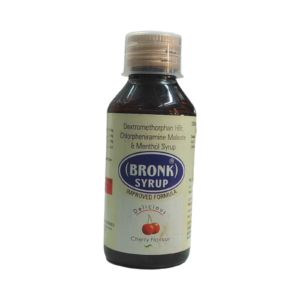CHLORPHENIRAMINE + DEXTROMETHORPHAN + MENTHOL
Chlorpheniramine: Chlorpheniramine is an antihistamine drug that is commonly used to treat symptoms associated with allergies, such as hay fever, itchy skin, watery eyes, and sneezing. It can also be used to relieve symptoms of the common cold, as well as allergic reactions to insect bites and stings.
The mechanism of action of Chlorpheniramine involves blocking the effects of histamine, which is a chemical released by the body during an allergic reaction. By blocking histamine receptors, Chlorpheniramine helps to reduce the allergic response and alleviate symptoms.
The recommended dose of Chlorpheniramine varies depending on the specific formulation and the age of the patient. It is available in different forms including tablets, capsules, syrups, and extended-release tablets. It is important to follow the instructions provided by the healthcare professional or read the package insert for the correct dosage.
Common side effects of Chlorpheniramine may include drowsiness, dry mouth, blurred vision, dizziness, difficulty urinating, and constipation. It is worth noting that drowsiness can be more pronounced in some individuals, so caution should be exercised when driving or operating machinery while taking this medication.
Additionally, Chlorpheniramine may interact with other medications such as sedatives, tranquilizers, and certain antidepressants, potentially increasing the risk of side effects. It is important to inform healthcare professionals about all the medications being taken to avoid any potential drug interactions.
Chlorpheniramine should not be used in children younger than two years old unless directed by a doctor. Pregnant or breastfeeding individuals should also consult a healthcare professional before using this medication to evaluate the potential risks and benefits.
Dextromethorphan: Dextromethorphan is a medication commonly used as a cough suppressant. It is available over-the-counter and is found in various cough and cold products.
Its mechanism of action involves acting on the central nervous system to inhibit the cough reflex. Dextromethorphan targets the cough center in the medulla oblongata of the brain, reducing the urge to cough.
The recommended dose of dextromethorphan may vary depending on the formulation and the specific product being used. It is important to follow the instructions on the package or as directed by a healthcare professional. Typically, the adult dose ranges from 10 to 30 milligrams every 4 to 6 hours, not exceeding a total daily dose of 120 milligrams.
While generally considered safe when used as directed, dextromethorphan can have some side effects. Common side effects include drowsiness, dizziness, nausea, and upset stomach. Some individuals may also experience allergic reactions, such as rash, itching, or swelling. It is important to discontinue use and seek medical attention if any severe side effects occur, such as difficulty breathing, rapid heartbeat, or hallucinations.
It is crucial to note that combining dextromethorphan with certain medications, such as monoamine oxidase inhibitors (MAOIs), can lead to serious drug interactions and potentially life-threatening serotonin syndrome. Therefore, it is important to check for any potential drug interactions before using dextromethorphan.
Overall, dextromethorphan is a commonly used cough suppressant that helps relieve cough symptoms by targeting the brain’s cough center. It is generally safe when used as directed, but it is important to be aware of its potential side effects and drug interactions. It is recommended to consult with a healthcare professional before using dextromethorphan, especially if there are any underlying medical conditions or if taking other medications.
Menthol: Menthol is an organic compound derived from mint plants, particularly peppermint and spearmint. It is widely used as a topical analgesic and a counterirritant in various medical and non-medical products.
One of the primary uses of Menthol is as a cooling agent to relieve minor aches and pains, such as muscle or joint pain. It is often found in topical products like creams, ointments, gels, and patches designed to alleviate pain. These products are typically applied directly to the affected area, providing a cooling sensation that helps to numb the area and reduce discomfort.
The mechanism of action of Menthol involves its ability to activate the cold-sensitive receptors in the skin known as TRPM8 receptors. By stimulating these receptors, Menthol produces a cooling sensation, which can help mask the feeling of pain and provide temporary relief. Additionally, Menthol also acts as a mild local anesthetic, further aiding in pain relief.
The dose of Menthol varies based on the specific product and the condition being treated. It is important to carefully follow the instructions provided by the manufacturer or the healthcare professional’s recommendation. Usually, a small amount of the product is applied topically and massaged into the affected area 3-4 times a day, or as needed.
When used topically, Menthol generally has minimal side effects. Some individuals may experience a mild burning or stinging sensation upon application, but this typically subsides quickly. Rarely, an allergic reaction may occur, causing skin irritation, redness, or rash. It is important to discontinue use and seek medical attention if any severe allergic reactions or worsening symptoms occur.
It is worth noting that Menthol should not be applied to broken or irritated skin and should be kept away from the eyes, mucous membranes, or sensitive areas of the body. Menthol is generally considered safe when used as directed, but it is always advisable to consult a healthcare professional before using any new medication or product, especially if you have any underlying health conditions or are taking other medications.


